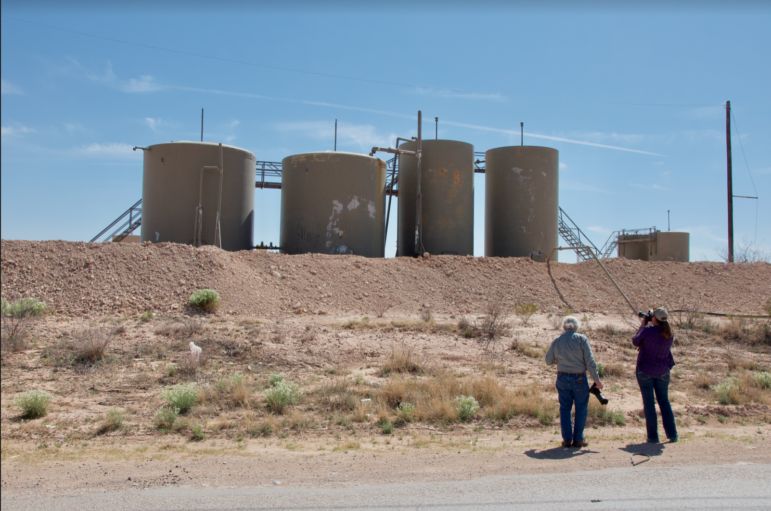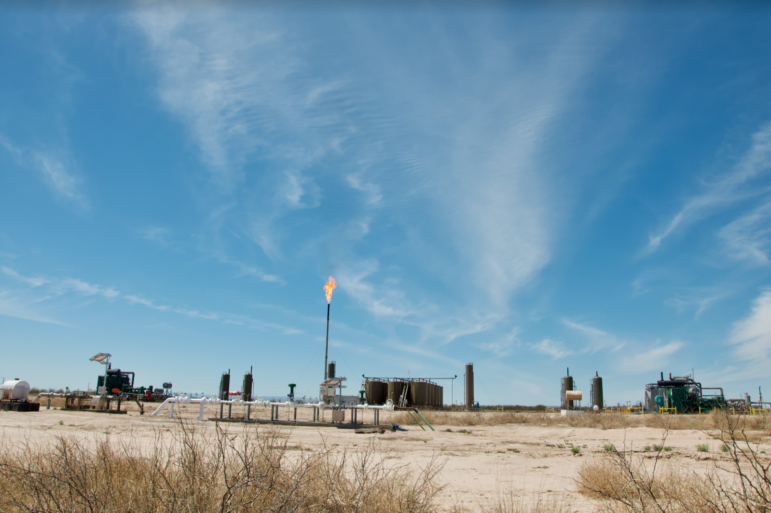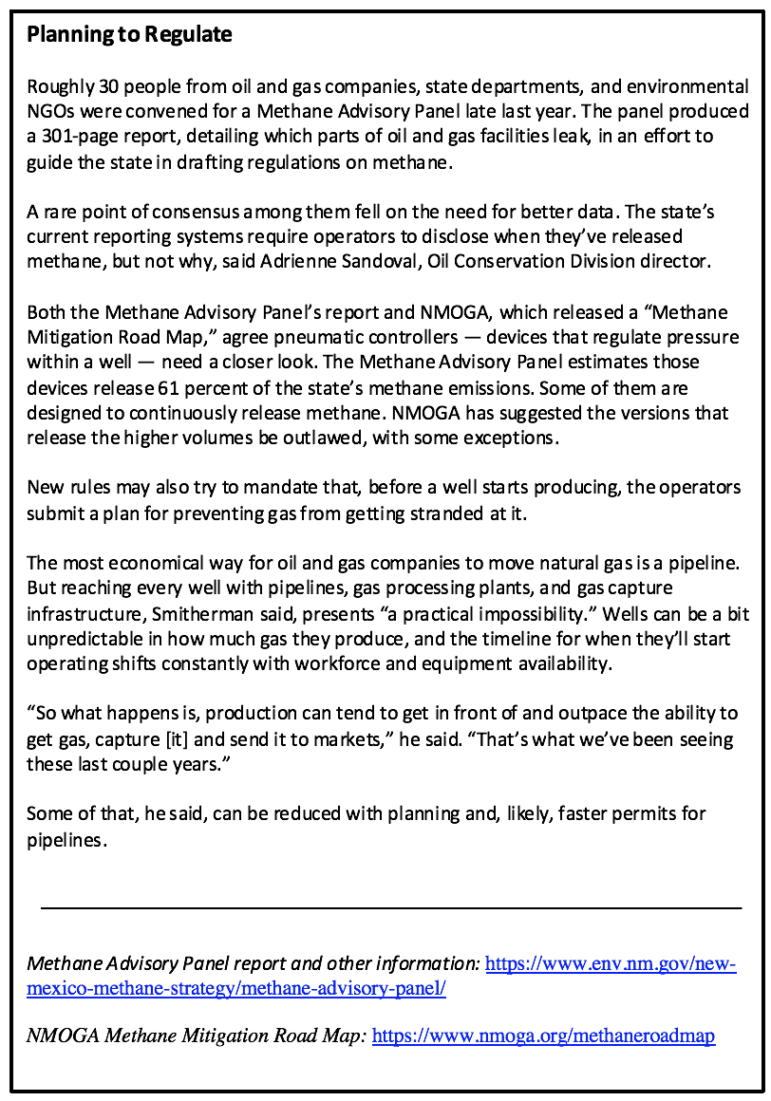The naked eye can’t tell you much about methane. Sometimes, distortion wavers above an open pipe or tank at an oil and gas well like the haze of heat over a desert highway. When Earthworks’ Sharon Wilson aims her FLIR camera, however, the screen renders the scene in black and white and plumes of black smoke can be seen wafting skyward.
“There are so many pipes and vents and tubes, it’s a lot of opportunity for holes,” said Nathalie Eddy, a field advocate with Earthworks, an environmental organization that monitors and reports methane emissions to regulators. “This industry is built to leak.”
Oil and gas engineers say that’s the system releasing pressure before it compromises equipment, well production, or worker safety. But those pressure valves leak methane.
When lit, flares top pipes with several feet of orange flames. The process burns off natural gas, the primary component of which is methane. A flare burning efficiently can consume about 98 percent of methane and other air pollutants emerging from wells. They’re intended only to burn through the early stages of a well’s life — New Mexico’s regulations give operators 60 days to move onto a system that captures and transports the gas to be sold and used.
But flares can blow out and equipment designed to automatically relight them can malfunction. That’s when they spew methane, joining leaks and pressure control devices that deliberately vent the gas as ways it enters New Mexico’s atmosphere.
Visiting the Permian Basin, the vast oil-producing region in western Texas and southeastern New Mexico, earlier this year, Wilson and Eddy saw signs the industry was cutting back. Oil prices had begun plummeting, though this was before the full weight of the COVID-19 pandemic had hit.
“It was already pretty obvious that these guys were working with shorter crews and fixing less equipment,” Wilson said. “There’s an increase in unlit flares and a big increase in tank emissions.”
In the atmosphere, methane is a significant driver of climate change. Associated air pollution can also compound respiratory problems, putting individuals in communities closest to the state’s oil and gas fields at greater risk from COVID-19.
Wilson, a certified optical gas imaging thermographer, has trained her camera on unlit flares and watched an afternoon breeze send a cloud of emissions toward a nearby house.
“It’s not really realistic to think that that situation is going to get better now,” Wilson said. “There’s no money to fix anything, there’s no workers to fix anything, and, as if they needed it, they’re getting regulatory relief.”

Citizen scientists’ reports and video documentation submitted to the state have prompted notices to operators of potential violations. Image: Elizabeth Miller.
To cushion the economic hardship oil and gas companies face in an historic downturn, federal authorities have loosened enforcement and slashed royalty fees. State authorities have offered some flexibility, too, as long as rule exemptions don’t risk public health or the environment. As oil and gas operations struggle, some activists, researchers and government officials worry that companies could declare bankruptcy, abandoning wells while others might forego fixing leaks to save money.
The state is scheduled to release draft regulations to reduce methane emissions this summer, per an executive order from Gov. Michelle Lujan Grisham. Some industry advocates caution against adding rules and expenses to an industry in recovery mode — and insist the industry won’t shirk its responsibilities during the downturn.
“The companies that are members of NMOGA, the vast majority of them really try to do their business responsibly, and they’re cast in a negative light without deserving that,” said John Smitherman, New Mexico Oil and Gas Association’s senior regulatory advisor. “They’re still going to try to be responsible, even in this bad oil market.”
The dangers of methane
Methane causes 25-times more warming than carbon dioxide does in a century, according to the U.S. Environmental Protection Agency. That matters in a state where the average annual temperature has climbed 2.7 degrees F over the last four decades, a change that affects snowpack and water supplies, threatens farming and ranching with aridification, and reshapes forests. Roughly a third of New Mexico’s greenhouse gas emissions — an outsized portion compared to national numbers — are methane, and more than half of it comes from natural gas and petroleum production.
Scientists with the Environmental Defense Fund, Harvard University, Georgia Tech and the SRON Netherlands Institute for Space Research estimated 3.7% of the gas produced in the Permian is leaked into the atmosphere. That’s enough to supply every home in New Mexico for a year, and 60 percent higher than the national rate, according to their study, which was published in Science Advances in April. Extensive venting and flaring caused by “insufficient infrastructure to process and transport natural gas,” the study’s authors concluded, likely feeds emissions.
Climate change isn’t the only problem with methane. It emerges from wells alongside other pollutants and creates ground-level ozone hazardous to humans. Seven counties in New Mexico already see levels of ozone that exceed recommendations.
Those other pollutants include volatile organic compounds, chemicals that can cause headaches, nasal irritation, organ damage, and cancer. The Environment Department estimates that in 2018, permitted emissions of volatile organic compounds in the state’s largest oil-producing counties, Lea, Eddy, and San Juan, topped more than 192.9 million pounds.

Flares burning in the Permian Basin are visible at dusk from Carlsbad Caverns National Park. Image: Elizabeth Miller.
Now more than ever, that exposure matters.
The Navajo Nation has the highest per-capita rate of COVID-19 infections, and one of the highest death rates in the nation.
“This respiratory virus shines a bright light on our air quality,” Mario Atencio, with the Chaco Canyon Coalition and a member of the Methane Advisory Panel, said during a May 19 online presentation about the latest on the methane regulations.
“Air pollution can exacerbate respiratory diseases like asthma, emphysema, and cause heart disease,” Atencio said, noting that people with these underlying conditions are at most risk for serious complications and adverse outcomes from COVID-19. “Given that oil and gas operations are a major source of ozone-forming pollutants, it’s more important than ever for Gov. Lujan Grisham to move forward with strong methane and ozone regulation.”
A health impact analysis conducted among Navajo residents in part of the San Juan Basin found the majority living within a mile of a well. In a month of air monitoring, eight readings reached levels considered hazardous. Residents reported sinus pain, discharge, headaches and other symptoms consistent with repeated exposure to elevated levels of the contaminants found in air samples. Readings also showed formaldehyde, a persistent pollutant linked to chronic respiratory effects and some forms of cancer.
“The very same health impacts that are created by oil and gas pollution — asthma, heart disease — are the same conditions that make COVID-19 hit populations that much harder,” said Jon Goldstein, director of regulatory and legislative affairs with the Environmental Defense Fund, which produced an interactive PermianMAP to give public access to emissions data from the Permian.
Stay-at-home orders have led to a likely unprecedented 17% drop in global carbon dioxide emissions. But in late March, the International Energy Agency, a nearly 50-year-old energy policy advocacy group that takes an “all-fuels, all-technology approach,” released a forecast suggesting methane emissions could rise through the economic downturn.
“A decline in revenues from oil and gas operations could mean that companies pay less attention to efforts to tackle methane emissions,” the IEA’s report reads. “Low natural gas prices may lead to increases in flaring or venting, and regulatory oversight of oil and gas operations could be scaled back.”
Regulating during an economic crisis
Balancing methane regulation with the importance of the industry to New Mexico’s economy poses a challenge for regulators. With oil and gas royalties and taxes providing about 45% of last year’s state budget, the state feels every ripple in the industry’s boom-and-bust cycles. A $1 change in the annual average price of oil amounts to a $22 million impact on the general fund and a $.10 price in natural gas makes a $17 million difference.
In the last 10 years, oil and gas production in New Mexico has increased more than 600 percent, according to the state’s Oil Conservation Division. The Permian Basin now ranks as the nation’s leading oil and gas producer. It also tops the nation for methane emissions, according to the study published in Science Advances.
According to a report by the New Mexico Oil and Gas Association, an analysis of EPA methane emissions data shows a decline in total volume of emissions yearly even as production increased, which NMOGA attributes to voluntary measures to limit the loss of natural gas from the oil field.
Now, the oil and gas industry is contracting and, along with it, the taxes and fees the state depends on. Oil and gas companies were hit with low prices as Russia and Saudi Arabia flooded the market earlier this year, and demand has decreased as cars remain parked and planes grounded during the pandemic.
The number of drill rigs, permit applications, and capital spending in the Permian have all dropped. Unemployment is up. State lawmakers will meet this month to deal with budget shortfalls for the coming year estimated at $2 billion.
Some industry representatives have asked the state to consider those conditions when adding regulations, which inevitably come with costs to implement.
“It would be lovely if we could get some relief on timing,” said John Smitherman, New Mexico Oil and Gas Association’s (NMOGA) senior regulatory advisor. “Every dollar that a company has to spend is a dollar that comes out of what they can pay people.”

Oil and gas wells burn off natural gas after they are first drilled. If the fires go out, they can vent methane directly into the atmosphere. Image: Elizabeth Miller.
State and federal authorities have already moved to ease some regulations to help companies weather the COVID-19 economic crisis. The U.S. Environmental Protection Agency told industries it’s loosening enforcement on air and water pollution and hazardous waste, as well as reporting requirements, because of potential COVID-19-caused worker shortages and travel and social distancing restrictions. Companies are also applying for waivers on royalties, some seeking cuts from the federally set rate of 12.5% to 0.5%.
The New Mexico Environment Department offered case-by-case extensions for testing, monitoring and record-keeping and suspended in-person air quality inspections. The Energy, Minerals and Natural Resources Department’s Oil Conservation Division has also allowed extensions to environmental remediation and reclamation work, gas and water analyses, abnormal well condition investigations and repairs, and field compliance issues.
Adrienne Sandoval, Oil Conservation Division director, cautioned it’s not a blanket exception and said inspectors still visit sites daily. “We caveated multiple times within that order that we’re not able to offer flexibilities if it threatens public health or the environment,” she said.
State royalties and taxes are set at a percentage of the current price of oil, so while those prices are low, to save oil for a better market — and let companies and the state make more money from that resource — the State Land Office and Oil Conservation Division have offered operators a chance to temporarily block or “shut in” wells, so that they don’t release oil. Typically, stopping production violates lease agreements that bind the oil company to keep producing, even if they would be doing so at a loss.
With a barrel of oil forecast to stay around $30 this year, and 2021 perhaps seeing $40 per barrel, State Land Commissioner Stephanie Garcia Richard said, “That doesn’t behoove us to develop a resource that’s finite, that will never come back, at this price.”
In general, wells in New Mexico become profitable around $40 per barrel.
Around 200 applications had come in to the State Land Office as of mid-May to temporarily shut-in wells, and Garcia Richard expected that number to grow. The Oil Conservation Division received more than 3,400 such applications. Reopening a well can cost tens or even hundreds of thousands of dollars.
Regulators work to head-off economic hardship’s long-term effects
Allowing temporary shut-offs aims to prevent wells from becoming a long-term environmental hazard. When oil and gas companies go bankrupt, as by one estimate some 40% are poised to do with oil at $30 per barrel, they can leave behind improperly sealed wells. Those wells can leak pollutants into the water and air.
More than 3 million of these “orphan” oil and gas wells exist across the country, according to the EPA. Interstate Oil and Gas Compact Commission representative Lynn Helms told the House Subcommittee on Energy and Mineral Resources on June 1 that the COVID-19 crisis could lead to an additional 210,000 abandoned wells.
In New Mexico, plugging a well with cement costs $35,000, on average. The state hires contractors each year, and fills roughly 50. That money comes from taxes oil and gas operators pay into a remediation fund as well as from the U.S. Bureau of Land Management for wells on federal land. The Oil Conservation Division knows of at least 708 that were awaiting remediation work well ahead of this crisis.
Sandoval said the temporary shut-ins should keep from adding to that list.
“There’s always the potential that wells will be abandoned as companies go bankrupt, but this process should not heighten that,” she said. “It should buffer against that.”
How many companies with NMOGA might face a tipping point toward bankruptcy with the cost of implementing new regulations, Smitherman couldn’t say. But he isn’t worried about a dramatic increase in abandoned wells.
The industry will boom again, he said, and the price of a barrel of oil will eventually rise back to $50, as it was three months ago.
“Am I worried that we’re going to have a tidal wave of abandoned wells out there? No, I’m not,” he said. “Will there be a few? Probably a few, but the industry can take care of that. … If a company goes belly up and those properties are still valuable, somebody still owns them, and another company can buy them and continue to produce them.”
The state requires bonds from oil and gas companies to cover remediation costs if a well is abandoned. On federal land, it’s $250,000 for any number of wells. On state land, it’s $25,000.
Garcia Richard ran a memorial in this year’s legislative session to garner buy-in for a study about how much they’d need to increase that bond to cover actual costs, but it died.
It was another point at which lawmakers balked at asking more from the industry, which actively works to maintain influence within the Legislature. In 2019, a measure to increase the royalty rate died, and while a bill passed to allow the Oil Conservation Division to fine companies for spills and other violations, it did so only after committees cut financial penalty amounts.
“This industry has had an outsized influence in our legislature, and yeah, I understand, we are heavily reliant on the revenue that comes in, but it should not prevent us from doing the right thing,” Garcia Richard said.
Because the methane rules stem from executive order and will be approved by the Oil Conservation Commission and the Environmental Improvement Board, they’re largely out of state lawmakers’ hands. Still, as they head into a special session this month, Garcia Richard said she hopes this crisis catalyzes change.
“This pressure gives us this chance, now, to look at a comprehensive transition away from such a heavy reliance from an industry that is boom-and-bust in nature, and that has implications for our fresh water, for our air, and really start to look at something more sustainable for our revenue,” she said. “It is all about political will, and nothing pushes political will like a crisis.”

Correction: This story has been updated to reflect that Garcia Richard ran a memorial rather than a bill during the legislative session to study bonding amounts for energy operations, and to remove a statement that the governor provided funding for the study after the memorial died. She did not.
